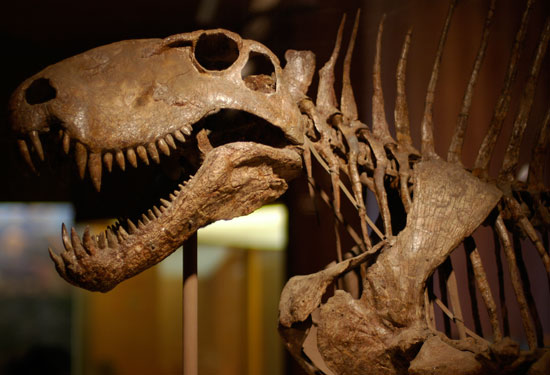Dinosaurs are hot-blooded and active
Professor Roger Seymour works at the School of Environmental Science & Earth, University of Adelaide, Australia, has applied the latest theories of anatomy and physiology in humans and animals, to provide insight. into the life of dinosaurs. The results of the study will be published in July on the Proceedings of the Royal Society of Biology.
The human thigh bone has small holes called " nutrient holes " on the axis that supply blood to the living bone cells inside. A new study has shown the size of nutrient holes is related to the maximum rate at which a person can function during aerobic exercise. Professor Seymour used this principle to assess the level of dinosaur activity.

The size of the dinosaur bones on the fossilized bones reveals that they are warm-blooded and active creatures.
"The external look is difficult to identify, but actually bone cells have a relatively high metabolic rate and therefore require a large blood supply to supply oxygen to the internal bone cells, the Blood supply is usually from an artery and vein through a nutrient hole on the axis of nutrient holes in the femur , "Seymour said.
Professor Seymour wondered: Can the size of the nutrient hole show how much blood is needed to keep the bone in good condition? For example, in animals with high motor activity can cause many tiny fractures in the bone, a need for more frequent repair by bone cells and therefore a high blood supply is needed. more .
" My goal is whether we can use dinosaur fossil bones to understand the level and speed of bone metabolism and can expand this study to understand the entire process of giving. their body's metabolism , "Seymour said. " One of the big arguments among paleontologists is whether dinosaurs are cold-blooded or hot-blooded; they are slow or agile? The size of the dinosaur bone transport hole may be a measure of their metabolic rate ".
The comparison is made with the dimensions of nutrient holes in mammals and live reptiles, and their metabolic rate. Mammals ( from mice to elephants ) and reptiles ( from lizards to crocodiles ), according to Sarah Smith, one of Professor Seymour's elite students, who scrutinized the collections. of Australian museums, taking pictures and measuring hundreds of small nutrient holes in the femur of the animals.
" The results are so obvious, the size of nutrient holes is closely related to the maximum metabolic rate during the peak movement in mammals and reptiles, " Professor Seymour said. know. " The nutrient holes found in mammals are about 10 times larger than those in reptiles ."
These nutrient holes are compared to the nutrient holes of fossil dinosaurs. Dr. Don Henderson, curator of the Royal Tyrrell Dinosaur Museum in Alberta, Canada, and Daniela Schwarz-Wings in the Museum für Naturkunde, Humboldt University, in Berlin, Germany, has conducted nutrient hole measurements of 10 giants long from 5 different groups, including carnivores and herbivores, with two legs and four legs, weighing from 50kg to 20,000kg.
" On a relative comparison to eliminate differences in body size, all dinosaurs have larger nutrient holes in their femur than in mammals," Professor Seymour said. know.
" Dinosaurs seem to be more active than mammals. We didn't expect to see that. The results provide additional evidence for the theory that dinosaurs are warm-blooded and active creatures. very positive, rather than cold-blooded and sluggish creatures ".
Professor Seymour said, the results of the study could be a simple measurement of the size of bone nourishment holes used to assess the maximum level of activity in other vertebrate groups, including including creatures living on earth and fossils.
- New hypothesis about dinosaurs
- Signs that dinosaurs are warm-blooded animals
- The dinosaurs also have warm blood
- New discovery: Dinosaurs are not cold-blooded!
- Decipher the mystery of the dinosaur's blood
- 10 weird, hard to imagine dinosaurs
- Body heat dinosaurs higher than any other animal
- The cause of dinosaurs extinction
- What is cold-blooded animals? Basic information you need to know
- How dinosaurs dominate Earth? That era begins with the Great Extinction
- What would happen if humans were ... 'cold-blooded animals'?
- Cold-blooded animals are able to adapt quickly to climate change
 Discovered an ancient centipede fossil 99 million years old
Discovered an ancient centipede fossil 99 million years old Discovered bat-like dinosaurs in China
Discovered bat-like dinosaurs in China Discovered a 200-year-old bronze cannon of the coast
Discovered a 200-year-old bronze cannon of the coast Discover 305 million-year-old spider fossils
Discover 305 million-year-old spider fossils